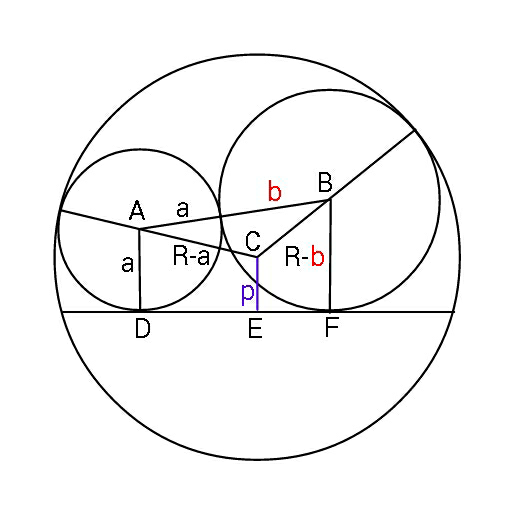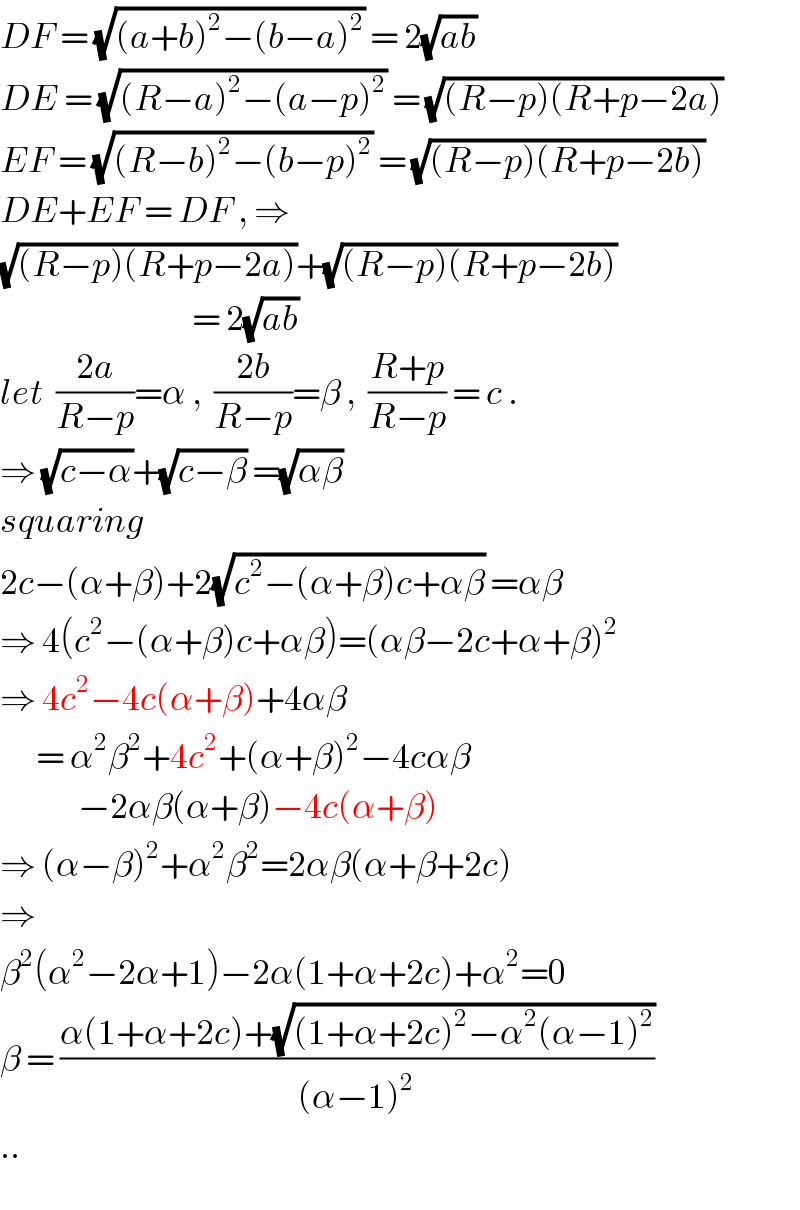Question Number 54170 by ajfour last updated on 30/Jan/19

Commented by ajfour last updated on 30/Jan/19

$${Determine}\:{b}\:{in}\:{terms}\:{of}\:{a},{p},{R}. \\ $$
Answered by ajfour last updated on 30/Jan/19

$${DF}\:=\:\sqrt{\left({a}+{b}\right)^{\mathrm{2}} −\left({b}−{a}\right)^{\mathrm{2}} }\:=\:\mathrm{2}\sqrt{{ab}} \\ $$$${DE}\:=\:\sqrt{\left({R}−{a}\right)^{\mathrm{2}} −\left({a}−{p}\right)^{\mathrm{2}} }\:=\:\sqrt{\left({R}−{p}\right)\left({R}+{p}−\mathrm{2}{a}\right)} \\ $$$${EF}\:=\:\sqrt{\left({R}−{b}\right)^{\mathrm{2}} −\left({b}−{p}\right)^{\mathrm{2}} }\:=\:\sqrt{\left({R}−{p}\right)\left({R}+{p}−\mathrm{2}{b}\right)} \\ $$$${DE}+{EF}\:=\:{DF}\:,\:\Rightarrow \\ $$$$\sqrt{\left({R}−{p}\right)\left({R}+{p}−\mathrm{2}{a}\right)}+\sqrt{\left({R}−{p}\right)\left({R}+{p}−\mathrm{2}{b}\right)} \\ $$$$\:\:\:\:\:\:\:\:\:\:\:\:\:\:\:\:\:\:\:\:\:\:\:\:\:\:\:\:\:\:\:\:=\:\mathrm{2}\sqrt{{ab}} \\ $$$${let}\:\:\frac{\mathrm{2}{a}}{{R}−{p}}=\alpha\:,\:\:\frac{\mathrm{2}{b}}{{R}−{p}}=\beta\:,\:\:\frac{{R}+{p}}{{R}−{p}}\:=\:{c}\:. \\ $$$$\Rightarrow\:\sqrt{{c}−\alpha}+\sqrt{{c}−\beta}\:=\sqrt{\alpha\beta} \\ $$$${squaring} \\ $$$$\mathrm{2}{c}−\left(\alpha+\beta\right)+\mathrm{2}\sqrt{{c}^{\mathrm{2}} −\left(\alpha+\beta\right){c}+\alpha\beta}\:=\alpha\beta \\ $$$$\Rightarrow\:\mathrm{4}\left({c}^{\mathrm{2}} −\left(\alpha+\beta\right){c}+\alpha\beta\right)=\left(\alpha\beta−\mathrm{2}{c}+\alpha+\beta\right)^{\mathrm{2}} \\ $$$$\Rightarrow\:\mathrm{4}{c}^{\mathrm{2}} −\mathrm{4}{c}\left(\alpha+\beta\right)+\mathrm{4}\alpha\beta\: \\ $$$$\:\:\:\:\:\:=\:\alpha^{\mathrm{2}} \beta^{\mathrm{2}} +\mathrm{4}{c}^{\mathrm{2}} +\left(\alpha+\beta\right)^{\mathrm{2}} −\mathrm{4}{c}\alpha\beta\:\:\:\:\:\:\: \\ $$$$\:\:\:\:\:\:\:\:\:\:\:\:\:−\mathrm{2}\alpha\beta\left(\alpha+\beta\right)−\mathrm{4}{c}\left(\alpha+\beta\right) \\ $$$$\Rightarrow\:\left(\alpha−\beta\right)^{\mathrm{2}} +\alpha^{\mathrm{2}} \beta^{\mathrm{2}} =\mathrm{2}\alpha\beta\left(\alpha+\beta+\mathrm{2}{c}\right) \\ $$$$\Rightarrow \\ $$$$\beta^{\mathrm{2}} \left(\alpha^{\mathrm{2}} −\mathrm{2}\alpha+\mathrm{1}\right)−\mathrm{2}\alpha\left(\mathrm{1}+\alpha+\mathrm{2}{c}\right)+\alpha^{\mathrm{2}} =\mathrm{0} \\ $$$$\beta\:=\:\frac{\alpha\left(\mathrm{1}+\alpha+\mathrm{2}{c}\right)+\sqrt{\left(\mathrm{1}+\alpha+\mathrm{2}{c}\right)^{\mathrm{2}} −\alpha^{\mathrm{2}} \left(\alpha−\mathrm{1}\right)^{\mathrm{2}} }}{\left(\alpha−\mathrm{1}\right)^{\mathrm{2}} } \\ $$$$.. \\ $$
Commented by mr W last updated on 30/Jan/19

$${good}\:{solution}\:{sir}! \\ $$
